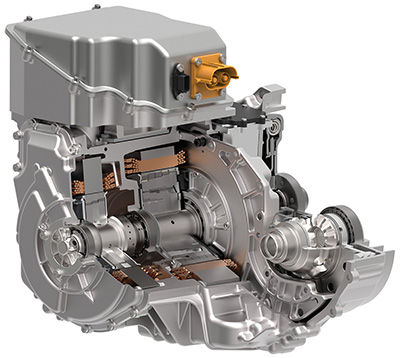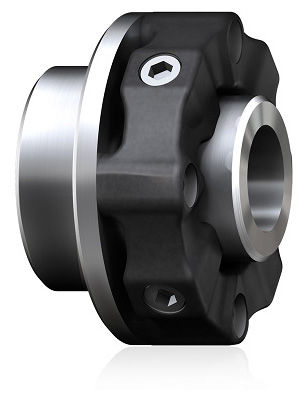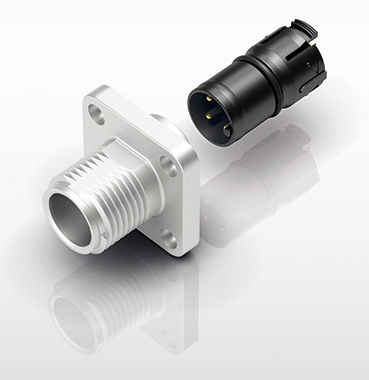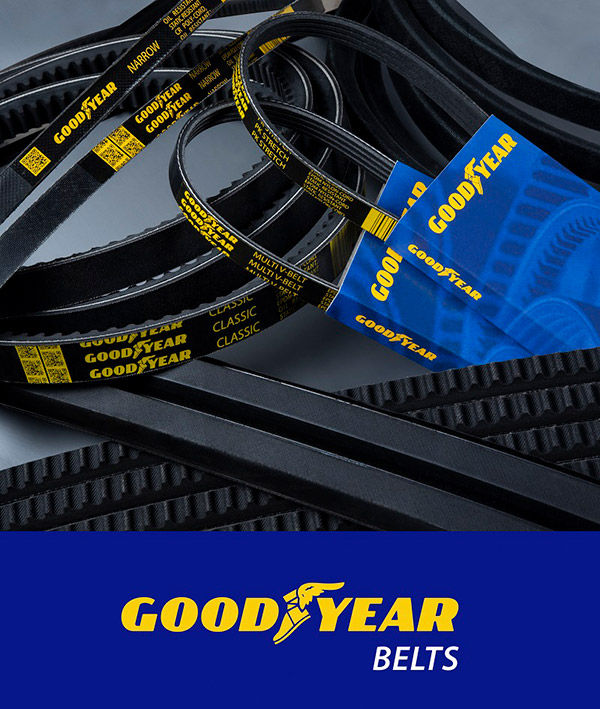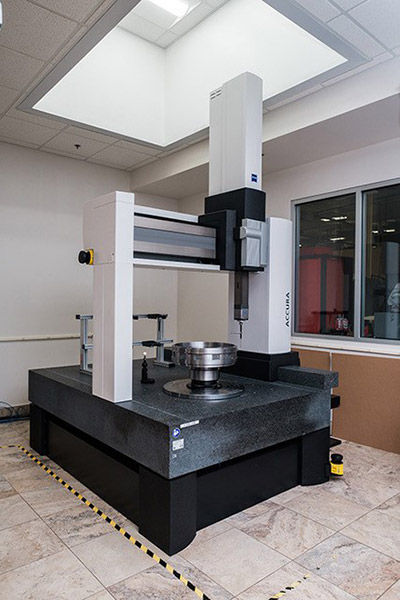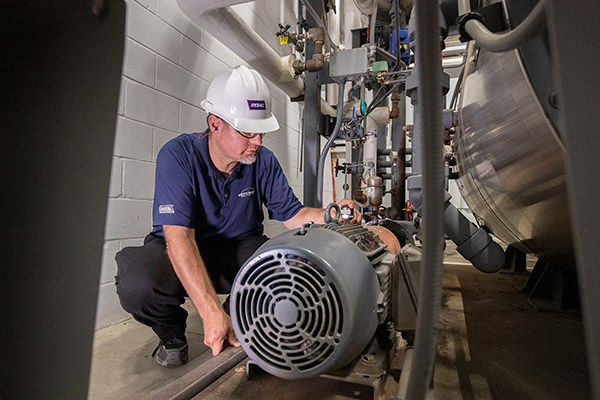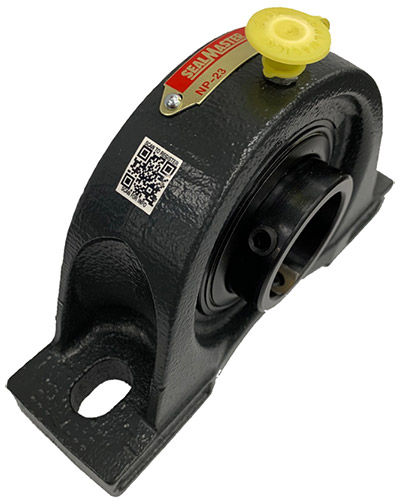The EVOLASTIC is the first new product release to evolve from KTR’s think tank which opened in 2019 and whose sole focus is new products.
www.ktr.com/us
Faulhaber
Offers Drive Solutions for Robotics Industry
Today, a world without robots is inconceivable. The areas of application that require process safety, reliability and economic efficiency from these robots are equally manifold. The drive systems from Faulhaber play a major role in fulfilling these requirements, and they continue to impress with their durability and performance in a robust and compact design. Due to these features, the drive systems can be used in a wide range of applications, from sewer robots and remote-controlled manipulators to robots for handling and logistics to surgical applications or prostheses. Whether high dynamics or precise positioning are needed, with its extensive range of products with more than 25 million possible combinations of microdrives, optical, magnetic or absolute encoders as well as speed and motion controllers with various interfaces, Faulhaber almost always has the perfect solution. At the same time, this technological construction kit is the basis upon which application-specific custom requests are realized, thus facilitating the further evolution of robotics.
In the past, small grippers that are both fast and powerful were always pneumatic. Because with compressed air, large amounts of pressure can be conveyed virtually without any time lag. But the elaborate infrastructure that was required for pneumatics is no longer needed today. Mechatronic gripping systems can now easily achieve the performance of their pneumatic counterparts thanks to brushless DC-motors with a diameter of only 22 mm and an integrated motion controller.
Faulhaber provides drive solutions for the robotics industry including DC servomotors with motion controllers.
Microdrives are also used in sewer systems. DC-motors with a diameter of just 15 mm and a precious metal commutation system mounted on inspection robots demonstrate how overload and schock-resistant as well as robust they are in daily use. The small drives confirm these characteristics in logistics as well. In this industry, an increasing number of work steps related to storing, retrieving and preparing items for dispatch is handled by intelligent robots. A typical unit comprising a lifting column and gripper used on a logistics robot contains a drive unit consisting of, e.g., brushless DC-servomotors with integrated Motion Controller and planetary gearhead. When used in the lifting column, for example, this combination ensures precise positioning during storage or retrieval – all during continuous operation with constant load changes. The small Faulhaber drive systems are thus represented in almost all areas of robotics.
www.faulhaber.com
Drivetrain Hub
Launches Gears App
Drivetrain Hub has launched its fully web-based gear software, Gears App.
Gears App is the only Software-as-a-Service (SaaS) gear development platform that integrates gear system modeling, design-for-manufacturing, industry standards, powerflow analyses, CAD, FE, 3D printing, manufacturing, data management, and collaboration tools. Model, analyze, and build gear systems for parallel-axis and planetary architectures.
Gears App is accessible online from anywhere on any operating system, no special hardware, software, or complicated license required. It is the only professional gear engineering software made available as an affordable monthly subscription service, entirely online. Just open your web browser and start using it.
drivetrainhub.com/gears
SICK and Ibeo
Collaborate on LIDAR Sensor for Automotive Applications
A technology partnership between Hamburg-based automotive LiDAR specialist Ibeo Automotive Systems GmbH and SICK AG has resulted in a 3D solid-state LiDAR sensor for industrial applications. The technology, developed by Ibeo to automotive standards, is based on a new photon laser measurement technique and is entirely free of moving parts. An additional, camera-like reference image adds a ‘fourth dimension’ to the measurement provided by the sensor.
The market for autonomous and semi-autonomous systems in an industrial context is predicted to grow at above-average rates. There is particular demand here for tough, ever-smaller and above all cost-efficient sensor solutions. The new solid-state technology from Ibeo works entirely without moving parts and features a compact form factor, thereby offering decisive advantages for mobile applications.
Now Ibeo and SICK have announced a technology partnership to develop a 3D LiDAR sensor based on this innovative solid-state technology from the automotive sector, for industrial applications. In this partnership, Ibeo is providing its ibeoNEXT measurement core. SICK will develop the system design and the application software for a new industrial LiDAR sensor so that industrial applications can be created to meet customer requirements.
“Autonomous systems will bring increasing changes to the industrial sector in coming years. Even outside industrial facilities there is much potential in mobile applications for the implementation of intelligent sensor solutions. The partnership with Ibeo will enable us to use a robust and highly-developed technology from the automotive segment for future-ready industrial applications,” says Dr. Robert Bauer, chairman of the executive board of SICK AG.
“Working together with SICK, we are making an automotive LiDAR sensor available on a large scale for industrial applications for the first time. In the industrial sector this is one of the largest LiDAR cooperation agreements ever concluded. Customers will profit from ibeoNEXT’s close-to-production development based on automotive standards and the high-quality standards that result from this, as well as the scale effects associated with it,” adds Dr. Ulrich Lages, CEO of Ibeo Automotive Systems GmbH. “We have had a long and close working relationship with SICK. Its extensive and in-depth application knowledge in the area of industrial applications and markets makes SICK an ideal partner to enable us to serve industrial markets.”
The ibeoNEXT measurement core was developed for large-scale automotive production and is based on an entirely new photon laser measurement technique for measuring the spatial distance of objects in medium to long ranges. Even in adverse environmental conditions, such as precipitation, or in situations subject to high levels of shock or vibration, the ibeoNEXT measurement core reliably obtains over 10,000 elements of distance information from each 3D measurement. It also generates a black-and-white image similar to that from a camera, which enables an even more reliable ‘4D’ detection of the surroundings.
“We decided to use Ibeo’s solid-state LiDAR technology because it is currently one of the most advanced 3D LiDAR measurement systems available in the world. It is an addition to our technology portfolio and enables us to offer, on top of our existing industrial applications, new, easy-to-integrate solutions in the field of autonomous and semi-autonomous driving for use in the industrial sector,” says Dr. Kay Fürstenberg, senior vice-president for research and development at SICK AG.
Selected customers of SICK will have the opportunity of testing this new 3D solid-state LiDAR sensor as early as in 2021.
www.sick.com
Miki Pulley
Brakes Assist with Satellite Control Positioning
Signals are effectively transmitted with the latest satellites when equipped with the newest Miki Pulley BXR-LE brakes. They effectively control satellite dish positioning using less power over long periods of operation.
The Miki Pulley brake opens and allows for free rotation when the satellite dish is panning and tilting, and snaps closed when power is disengaged holding precise position. When the satellite dish is in position for long periods of time, the brake consumes no voltage. The brake’s internal compression springs hold the armature plate against the rotor disc, holding movement. When voltage is re-applied, the brake opens and allows for position control.
These Miki Pulley brakes also act as a safety device during dish movement. If an unexpected power interruption occurs, the brake will halt and hold movement to mitigate potential mechanical damage to the satellite system.
www.mikipulley-us.com
Binder
Expands M12-A Connector Portfolio
Binder USA, LP, has expanded its M12-A connector portfolio with two new rectangular flange connectors. Designed for today’s advanced automation technology, the connectors provide new options for sensor and actuator applications.
The M12-A connectors include a stranded-wire version with 20mm or 26 mm rectangular housing, and a solder version with 20 mm housing. (The stranded-wire 26 mm version uses the same drilling template as the M16, allowing users to switch to M12 without changing the existing housing.) For simple and reliable installation, binder used a two-part approach consisting of the housing and the contact holder, allowing the coding nose of the contact holder to be positioned in increments of 45°.
www.binder-connector.us
Dana
Introduces Heavy-Duty Drivetrain for Rough-Terrain Cranes
Dana Incorporated has introduced a new drivetrain for rough-terrain cranes with lift capacities from 83 to 110 tons (75 to 100 tonnes) and terminal tractors.
The Spicer 246 heavy-duty steer axle and Spicer C3300 remote torque converter are offered as part of a complete drivetrain solution for rough-terrain cranes that delivers premium performance through improved gradeability and travel speeds, higher efficiency in the field, increased productivity, and reduced operating costs.
“As the global construction market recovers, buyers are looking for high-performing vehicles that deliver exceptional productivity and efficiency,” said Aziz Aghili, president of Dana Off-Highway Drive and Motion Systems. “Dana’s large and growing capabilities for rough-terrain cranes enable us to anticipate market shifts and collaborate with original-equipment manufacturers to supply the drivetrain technologies that improve their competitiveness.”
New Heavy-Duty Spicer 246 Axle
Dana’s new heavy-duty Spicer 246 steer axle features a monolithic axle design and high integrity seals that deliver exceptional performance in the most severe working conditions. It features optimized steering geometries to minimize slippage, while the single universal joint design with outboard planetary gears provides high output torque and high-capacity braking with low drag at travel speeds.
Currently available for OEM field testing, the Spicer 246 axle can also be adapted for use with airport ground support vehicles, where it can be configured with optional wet brakes.
Efficient Spicer C3300 Remote Torque Converter
Dana has developed the new Spicer C3300 remote torque converter specifically for rough-terrain cranes. It is optimized for engines up to 195 kW (260 hp) and can be packaged with Spicer remote transmissions. Dana is the only manufacturer worldwide that supplies a remote torque converter with three large pump drives for implements.
The Spicer C3300 remote torque converter is available with an optional lockup that improves efficiency while providing higher braking effort during downhill operation. It features new converter wheel sizes configured to optimize the performance of today’s low-RPM engine designs.
Available now, the Spicer C3300 remote torque converter is already in use in terminal tractor applications, where it enables lower heights for fifth wheels.
Broad Portfolio of Drive and Motion Systems for Cranes
Dana has a large and growing selection of drive and motion technologies for manufacturers of tracked and wheeled cranes.
Earlier this year, Dana introduced a new series of Spicer Torque-Hub drives for crawler cranes and other large tracked vehicles. With torque ratings from 80,000 N-m up to 450,000 N-m, the new drives offer flexible packaging and gear ratios to meet manufacturer preferences for tracked and wheeled applications.
Also, Dana offers high-performance Brevini winches for cranes and other applications with lift capacities from 1.1 tons (990 kg) to 33 tons (30 tonnes).
Additionally, Dana supports the work functions of cranes with a wide selection of Brevini slew drives, hydraulic pumps and motors, and proportional directional valves.
www.dana.us
Goodyear Belts
Produces Belts for the Automotive and Industrial Markets
Goodyear Belts, a licensee collaboration between Adventry and The Goodyear Tire & Rubber Company, has produced a line of power transmission belts targeting the demands of multiple markets globally. The line was launched on December 1, 2020 and offers belts for both industrial and transportation markets.
“We are thrilled to collaborate with such an iconic brand as Goodyear,” said Tara Cevallos, CEO of Adventry. “Customers expect a great product and that is what we will deliver, along with our outstanding service. We truly strive to put the customer first in everything that we do.”
“We are honored to be part of the incredible Goodyear heritage as we forge new relationships and product innovations,” added entrepreneur Jorge Gomariz, chairman and founder of Adventry.
Goodyear Belts’ new line features broad application coverage that meets or exceeds OEM specifications, refined engineering, and advanced manufacturing. Belt materials for both standard and specialty belts have been designed and tested to provide dependable and durable service.
www.goodyearbelts.com
Forest City Gear
Adds Zeiss CMM to Quality Assurance Department
Forest City Gear has expanded the capabilities of its Quality Assurance Department with the addition of a Zeiss ACCURA Coordinate Measuring Machine.
The next-generation bridge-type Zeiss is Forest City Gear’s fourth CNC inspection system, and is particularly well suited for very fast, complete analytical inspection of all types of high precision fine- and medium-pitch cylindrical gears. A variety of interchangeable Zeiss sensors provide a high degree of flexibility and faster calibration, approach and scanning for lead, involute, pitch, surface finish and other critical features across a wide size range.
The system also features a particularly compact and ergonomic design, making it ideal for Forest City Gear’s fast-expanding, busy Quality Assurance room. The Zeiss ACCURA’s bridge, for example, is made of steel and aluminum, making it extremely rigid, yet slim and compact. The reduced weight of the moving parts improves the dynamic rigidity and speed of the machine.
“The added capacity of the Zeiss ACCURA has now enabled Forest City Gear to move its existing Zeiss CONTURA CMM to meet the quality requirements of its new, stand-alone gear blanking facility,” according to Forest City Gear Quality Assurance Lead, Amy Sovina. “The ACCURA couldn’t have arrived at a better time, freeing up the CONTURA so we could put it in close proximity to the blanking operation and thus eliminate the travel time for inspection of blanks,” says Sovina. “The Zeiss ACCURA checks all the metrology boxes. With quality and throughput requirements never higher in all the industries we serve, this system is the perfect addition.”
www.forestcitygear.com
Altra Motion
Provides Stainless Steel Powertrains for Coastal Manufacturing
Edited by Matthew Jaster, Senior Editor
Hardly a day passes without a new FDA recall of some food product as the number of Americans falling ill from food contamination infections continues to rise.
While there are many causes of food poisoning, food processing equipment design plays a part. Motor and speed reducer drivetrains are found on all types of conveyors and equipment in food processing plants producing everything from beef and poultry to processed ready-to-eat products – in fact anything that people or their pets consume for nutrition or pleasure.
So, food processing equipment design, engineering and materials can play a big part in a plant’s drive for food safety excellence. Anything that can be done to minimize contamination and reduce the costs of sanitizing these units is a worthy investment.
Many drivetrains on food processing equipment feature belts, chains and external gears enclosed in a cover for safety. All of these provide very attractive homes for all types of bacteria and other contaminants. One solution is to utilize hollow shaft reducers, which allow conveyor drive rollers to mount directly to the reducer, eliminating the need for these bacteria harboring components.
Cast iron and aluminum speed reducers and motors are widely used in the food processing industry. Their lower initial cost compared to stainless steel models makes them attractive. However, if the life cycle cost is considered, that picture can change drastically. If the use of stainless steel reducers and motors helps to avoid a single line shutdown due to coating failure that could cause a contamination risk, the cost of the lost production may pay for the stainless steel several times over. Because of this, many manufacturers are moving to all stainless steel speed reducers and drive motors.
Boston Gear Stainless Steel 700 Series speed reducers were mounted to 3/4 hp stainless steel motors on conveyor drives in the system (photo courtesy of Coastal Manufacturing).
Besides the consequences and cost of a coating failure shutting down a production line, there is also the cost of keeping the line running. In one case, a poultry processor had laborers come in each weekend to paint and repaint gearboxes that had chipped paint or rust. This was done for each gear reducer at least once a year depending on the frequency of washdown. The cost of two of these re-coatings would have more than covered the cost differential between the gear reducers they were using and stainless steel gear reducers.
Coastal Manufacturing, a recognized industry leader, supplies custom designed equipment for food processing applications. According to Mark Hoffseth, a Coastal sales engineer, “Many of our customers face food safety audits that inspect every inch of their facilities and equipment, inside and out. Issues such as paint flaking or rust dripping in close proximity to a food contact area are unacceptable.”
This equipment is typically used in production 16 to 20 hours/ day with the remaining hours used to sanitize with a combination of high-pressure water, acids, and sanitizing agents. Hoffseth says, “In our experience, no carbon steel products, regardless of how robust or cutting-edge the coating or plating, have ever held up in this environment over time. There is no easy way on this one, we have tried virtually every ‘corrosion-resistant’ surface available, and stainless steel is the only long-term solution.”
For decades, the food processing and packaging industries have relied on Boston Gear 700 Series worm gear technology for long-lasting, high-quality performance. The Stainless Steel 700 Series takes that trusted performance to new levels by providing maximum corrosion resistance in the most challenging, caustic washdown environments.
Boston Gear reducers have the lowest maintenance requirement of any component they use at Coastal Manufacturing (photo courtesy of Altra Motion).
Hoffseth explained that when so-called “corrosion resistant” products fail, it is often much more costly to repair than with a stainless steel product. This is because, as they are failing, they are typically corroding and seizing onto the piece of equipment that they are mounted to. This can result in a far more difficult removal process, often damaging adjacent parts and components. Coastal has a 175-ton press in its shop, and there have been times when that press had to be used to remove seized, corroded parts. Typically, if that amount of force is required to remove a corroded part, there is often damage to other attached parts.
When asked about Coastal’s customers’ concerns regarding energy efficiency, cost of ownership, etc. Hoffseth said, “While these issues are important to everyone, I would say those are second-tier concerns. Food processing customers are mostly concerned with ‘is it food safe’? and ‘is this machine going to corrupt or harbor any product’? In most of the food and pharmaceutical areas that we work in, any equipment that contains corrosive parts is unacceptable. No question.”
Coastal had used painted speed reducers from Boston Gear and other manufacturers for at least 20 years and decided to standardize on Boston’s stainless steel units about 10 years ago. Hoffseth told us, “We have tried just about every brand of reducer – either due to customer specification or, often, because we are given other products to try out and there are some quality competitive reducers out there. But over the years, we have not found one that can beat the quality and availability of Boston Gear.”
Hoffseth acknowledged that Coastal has a very large number of Boston Gear stainless steel units in the field. While all parts wear and eventually require rebuilding or replacement, he said that the stainless steel Boston Gear reducers have the lowest maintenance requirement of any component they use. “We install them and forget about them, typically never having to hear about them or work on them again. For us, the bottom line is Boston has a quality product and has never missed a delivery due date. That’s the kind of company we want to work with, as that is the kind of company we are.”
www.altramotion.com
www.coastalmanufacturing.net
The Digital Experience with Regal Beloit
Company discusses digital strategy in 2021
Edited by Matthew Jaster, Senior Editor
Regal Beloit Corporation recently announced it is now putting QR codes on Sealmaster and Browning mounted bearings products and bearing boxes including Browining, McGill, Rollway, Sealmaster and System Plast. Customers now have access to product specifications, including all critical dimensions and features, and the Regal 2D and 3D CAD libraries, installation and maintenance instructions, and much more. PTE recently caught up with Dan Phillips, CMRP, technical director, monitoring and diagnostics, Regal Beloit, to discuss the company’s digital strategies moving forward.
Dan Phillips is the CMRP, technical director, monitoring and diagnostics, Regal Beloit.
PTE: Explain how Regal’s QR codes make it easier to improve the customer experience in 2021.
Phillips: Regal continues to look for ways to improve the customer experience. For instance, the company has added QR codes to products so that customers can easily scan them to access a mobile-friendly version of our website for additional product information. From the landing page, a user can receive direction on where to find additional production information, how to register the bearing for an extended warranty, where to obtain maintenance and installation information, and learn where to make a purchase. Where possible, these QR codes are applied to Regal mounted bearing products and will soon be added to Regal gearing products. If not found directly on the product, these QR codes can also be found on our bearing boxes.
Regal has also launched the Perceptiv Tag-It program. Utilizing QR codes which plant personnel can apply to motors, speed reducers, bearings and other mechanical equipment, users can track assets, consolidate inventory, speed up the replacement order process, and upgrade to Regal remote monitoring and diagnostics services.
Perceptive Technologies install.
PTE: What other digital tools and strategies is Regal implementing in the coming months?
Phillips: In 2020, Regal merged several product/brand websites into regalbeloit.com, and we will continue to enhance the tools and functionalities on the site. We continue to work to improve our customer digital experience and our currently upgrading our eCommerce platform and selection tools to product a streamlined integrated mobile-friendly experience.
PTE: How is smart manufacturing (IIoT, Industry 4.0, etc.) changing the way Regal conducts business? Describe the benefits of collecting more data from power transmission components via sensors, software etc.
Phillips: At Regal, we continue to embrace the evolution to smart manufacturing, and our Perceptiv monitoring and diagnostics lead the way. Our team utilizes remote monitoring for some of our customers’ critical equipment, providing real-time alerts and monthly performance reports. Fully integrating all of a facility’s mechanical components is possible, and we work with our customers to evaluate the cost benefits and overall ROI of doing so. For some, having their critical equipment monitored is enough, while others integrate our components into their existing smart ecosystem.
PTE: How has the pandemic altered your approach to digital solutions and strategies?
Phillips: Because the Regal PTS group had already migrated its digital tools to the new regalbeloit.com and continues to focus on improving the customer experience, we were ready for the remote interaction that the pandemic brought and the increased number of customers seeking information on our site. Less on-premises customer interaction in 2020 not only led to increased video conferencing, but also a strong focus on Perceptiv remote monitoring, which allows our team to help customers monitor the equipment in their facilities. We also expanded the Regal Training Academy.
Regal bearing QR code example
PTE: What are the greatest strengths of Regal’s mobile apps? How will these apps evolve in the coming years?
Phillips: The key focus of our mobile apps is putting information in the hands of our users via their ease of use. Our most popular and oldest app is the Browning HVAC Toolbox Technician App, and in 2020 we launched the Regal PT Mobile App. Both provide quick access to production, information, product interchanges and helpful tools. The Regal PT Mobile App allows users to register their Regal bearings for an extended warranty and then utilize its simple asset management function to schedule and track maintenance.
In 2021, we will be adding our gearing and component products to the Regal PT Mobile App. We will also expand the Perceptiv Mobile App, which allows users of our Tag-It program or remote monitoring to access information from their smartphone, laptop or desktop. In addition, we plan to continue to deploy mobile-friendly tools on the Regal website.
regalbeloit.com
